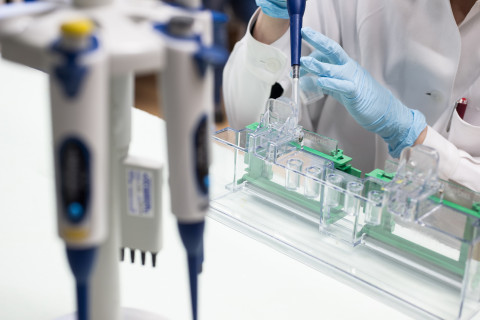Extracellular vesicles (EVs) are small lipid bilayer membrane bound vesicles, which are secreted to the extracellular space by all cell types. These vesicles were thought to be just the waste management system of the cells, when they were first detected in 1940s, but since then their significance as an important mechanism in intercellular communication has been revealed. Nowadays it seems obvious that these nanosized particles participate in a wide variety of physiological and pathological processes.
Hyaluronic acid, also called as hyaluronan (HA) is a glycosaminoglycan produced at the plasma membrane by three HA synthases HAS1-3. It is one of the major components of the extracellular matrix. Because of its negative charge HA is very hydrophilic molecule, which means that it can bind high amounts of water. In a solution HA forms a viscous gel. This property makes it an important space filler and lubricant in the body. However, HA has many other important functions in the body such as cell migration and proliferation. Importantly it has a role in cancer development.
CD44 receptor is a multifunctional transmembrane receptor, which has roles in regulating cell adhesion and migration. CD44 has an ability to interact with multiple ligands of which HA is the principal one. Even though CD44 is the product of a single gene, due to alternative splicing there are multiple isoforms of CD44. Expression of CD44 standard form (CD44s) and many of its variants is suggested to have a role in epithelial-to-mesenchymal transition, which is a key step in initiation of metastasis. In addition, CD44 expression seems to correlate with poor prognosis in some cancers.
In his doctoral thesis, Kai Härkönen, MSc, seeked to study how CD44 expression and HA influence EV secretion and to determine whether they are carried by EVs. CD44-HA interaction can affect EV-recipient cell communication in multiple ways. HA carried by EVs can contribute to EV binding on the cells which express CD44. On the other hand, CD44-positive vesicles may adhere to the HA-coat around the cells, respectively. CD44 regulated EV-recipient cell interaction is anything but an unambiguous process.
Previously it has been shown that overexpression of HA synthesis induces the secretion of EVs, and HA can be carried by EVs. The results of this study show that CD44 receptor is also carried by EVs. The researchers also detected that CD44 and EV-recipient cell interaction has a possible connection, since EVs given to recipient cells were shown to colocalize with areas on the plasma membrane with CD44. Interestingly CD44s expression itself in gastric cancer cells does not affect EV secretion. Epidermal growth factor (EGF) or wounding treatment of rat primary mesothelial cell cultures could induce epithelial-to-mesenchymal -like changes in cells. Treatments were also able to induce CD44 expression and EV secretion.
Based on these observations, CD44 has a role in EV-recipient cell interaction, but does not regulate the EV secretion rate. The results also support the earlier findings on the role of CD44 on EMT and tumorigenic properties of cells. In addition, based on this study, CLEM serves as a powerful tool to perform EV-research, combining the best features of light and electron microscopy.
The doctoral dissertation of Kai Härkönen, Master of Science, entitled CD44 and extracellular vesicles: Studies on the role of CD44 in vesicle biogenesis, detection and cellular interactions will be examined at the Faculty of Health Sciences on 18 January 2020. The Opponent in the public examination will be PhD, Head of Laboratory Rienk Nieuwland of the University of Amsterdam, and the Custos will be Docent Kirsi Rilla of the University of Eastern Finland.
Photo available for download at
https://mediabank.uef.fi/A/UEF+Media+Bank/35689?encoding=UTF-8


